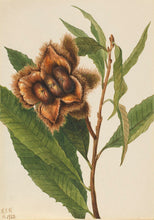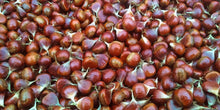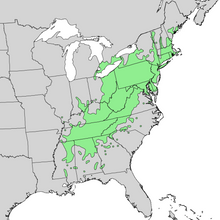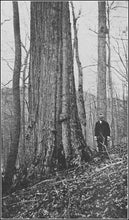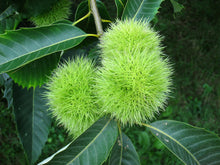American Chestnut
Regular price
$11.25
Sale
Our source for these incredibly rare seeds is the great Chris Homanics of Head, Hands, Heart Nursery and Seed in the state of Washington. Here's what he says about this special, very limited offering (if there are any in stock and you want some, you probably should order them now):
These seeds were collected from an isolated pair of blight-free pure American Chestnut (Castanea dentata) trees found in Western Oregon. Since 2005, I have been scouting and analyzing chestnut trees all over Washington and Oregon. Over the years, despite the many hybrids I’ve encountered with part American genetics, these are the first pure American trees I've found after examining around a couple thousand trees. After noticing that these trees were likely unhybridized Castanea dentata, I sent leaf and twig samples to chestnut expert Dr. Sandra Anagnostakis of the Connecticut Agricultural Experiment Station (CAES) for confirmation of species identification. A couple weeks later she wrote back excitedly that in over thirty years these were the first samples of pure American chestnuts ever sent to her from the Pacific Northwest!
According to the geologic record, American Chestnuts have not been in this region since at least the last ice age. All extant chestnut trees were brought here from either Asia, Europe, or the eastern United States. This region is unique in that we have been free of chestnut blight since the 1930s. We have remained so because our long dry Mediterranean summers do not support the fungal species’ proliferation. It is therefore highly possible that other pure American trees will be identified in the future. As the people who immigrated here had limited space in their wagons, boats, and trains, few people would bring saplings or easily perishable seed of chestnuts with them, so it is hardly surprising there are so few American chestnuts left here.
Most of the genetic diversity one sees in this region now are either pure species European, Chinese, or various hybrids between these and American, Japanese, or other species as well. As time has passed, these hybrid blends have naturalized, and seeds from the old plantings have also been replanted elsewhere. Many orchards were planted with American trees or American-hybrids as pollinizers, so hybrids with American genetics are not uncommon here.
American Chestnut seeds are naturally on the smaller side when it comes to chestnuts. These particular nuts are around the size of a nickel or a bit smaller. I have been told that thirty years ago this pair of trees produced nuts about twice their current size. This shrinkage is likely due to abusive chemical agriculture and deep ripping of the soil. (I have seen rotted chunks of chestnut roots in the field, torn up by soil work.)
For their size, these seeds pack in a lot of energy and are even sweet when raw (they’re really quite a treat that way) — they remind me of something like a sweeter hazelnut. When cooked, the chestnuts are richly flavored, still sweet, but also savory, and with a wonderful floury texture. As a species, Castanea dentata is higher in protein and oils than other chestnuts. They are also much denser, with a higher specific gravity (or relative density) than other chestnuts.
American Chestnuts are susceptible to blight and while there is no reason to believe trees grown from these seeds will display blight resistance, in many parts of the country (in particular places with few chestnuts or out west where blight has difficulty surviving) it is likely that trees grown from these seeds could survive for decades or longer. Even in places where blight is still prevalent, it’s possible that trees could survive to bearing age and produce seeds for a few years before being knocked down by blight (after which they will likely put on fresh growth, but it'll be a long time before it reaches maturity again). I strongly believe that American Chestnuts have important traits that should continue to be present in breeding programs to further develop hybrid chestnuts as a useful perennial staple crop, including extreme cold-hardiness, high productivity, excellent flavor, high nutritional value, and top-quality timber.
HOW TO STORE YOUR SEEDS
These nuts have been carefully cleaned and hand-sorted to help ensure your success. They have already begun their moist stratification in a refrigerator, so as soon as your package arrives you should place the bag in your refrigerator until you are ready to plant. Please note that these chestnuts will begin sprouting at room temperature. Do occasionally check the bag from time to time, and — if needed — rinse and gently scrub the chestnuts to make sure that mold or slime does not build up, removing any seeds that have significantly darkened, turned black, or have become mushy. If dry, mist a bit of water into the bag to maintain moisture levels at 100%, but ensure there is no standing water! Some people like to add a bit of duff to the bag, but I prefer the method described here so that I can see the nuts. Toward the end of stratification, you may notice the delicate radicle (root tip) emerging from the pointy end of the nut. Generally, germination is expected to be around 80%.
Let’s work together to preserve the American chestnut for future generations!
POSSIBLE PLANTING METHODS
“Sunken Container Method”
This method is best if you are limited in resources and/or would prefer to start them outside and preferably live in Zone 7 or higher. In a prepared nursery spot, you will use a large container or bucket, sunken into the ground, as a community container for your chestnut seedlings. The main concern with this method would be protecting the nuts from rats, mice, and squirrels — who will try everything possible to get these chestnuts! Prepare by cutting the bottom off of a bucket or large pot and sink that fully into the ground. Make sure to use sturdy metal screening (also called hardware cloth) on the bottom to keep out rodents. Fill the container with a rich well-draining acidic potting mix up to 2 inches from the top — do not use your native soil because it is typically too heavy and also because it will later be difficult to separate the taproots from each other. Press the nuts firmly into the growing medium and add 2 inches of medium so that the top of the full container is flush with ground level. Put another piece of that metal screen on top and weigh it down. Cover with fresh leaves — maple and oak work great.
It is important to carefully check the nuts around late February. Carefully remove the mulch and remove soil to the chestnut layer. Discard any blackened ones. Check periodically, and when germination begins you will first see the emergence of the brittle white radicle (root tip) from the pointy end of the nut. At this time, you can either choose to grow the trees on for a season in the community container before planting out in their final spot or place each good nut individually into their own pot and grow them in a nursery. If you wish to do the latter, follow on to the next paragraph. If you choose to continue growing them in this way, make sure to remove the metal screening so that the trees do not grow up through it!
“Nursery Tree Pot Method”
Whether you have done the “Sunken Container Method” or are planting nuts from the fridge, wait until the worst of winter has passed by. This will typically be sometime from February to April depending on your growing zone.
I prefer to use tall tree pots with root pruning holes which seem to be optimal for growing chestnuts as nursery stock since they have long tap roots. If you don’t have those, you can also use 2 gallon or larger pots. Place one viable nut into each pot and cover with about 1-2 inches of soil mix. Again, make sure to use an acidic potting soil mix. Once germinated, chestnuts gain a lot of tannins and are less palatable to rodents. That said, still be vigilant and do your best to keep rodents away from the sprouted nuts for at least the first half of the growing season.
Siting Your Chestnut Trees
When you're planting them out in their final spot, prepare a 2-foot by 2-foot area, first by clearing the weeds away, then adding some compost and mulch. In a good climate and proper location, chestnuts can grow 3 or 4 feet in height and add one inch in girth per year. The trees should begin flowering at around 7 years but could take up to 10 years to flower. Trees should be spaced at least 20 feet apart, though tighter spacing can be used if timber is desired and thinning will occur at a later date. They can be pruned to be kept straight if lumber is your goal and will become harvestable after two decades. Choose a place with good sun and exposure, like the edge of a field. Traditionally, chestnuts have been considered a tree crop of the hillsides. It is imperative that the soil be acidic and well-draining with no standing water. Mulch with leaves around the plant the first couple years. Though chestnuts are ultimately very drought tolerant, it is important to irrigate young trees adequately during any dry months to ensure proper growth and survival.
A full treatment of growing chestnuts is beyond the scope of this document, but there are some great resources available as books, websites, and particularly the Facebook page “Chestnuts as a tree crop - Castanea species nut trees”. Good luck!






